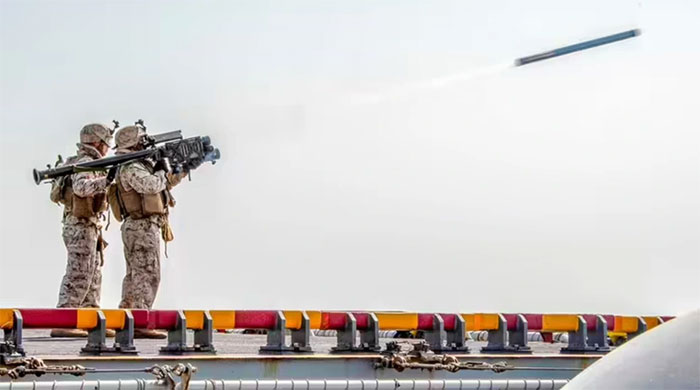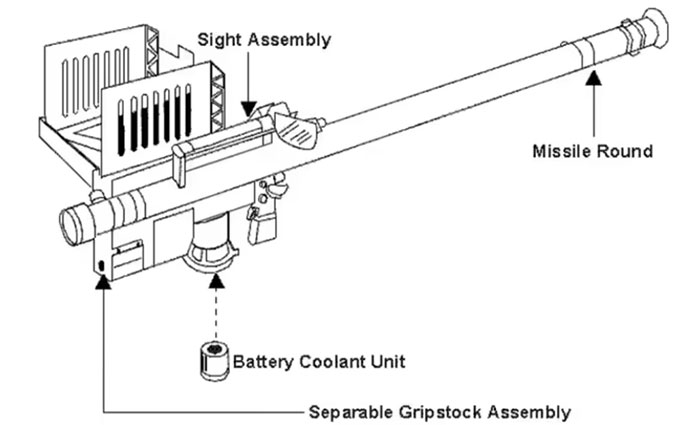How does the Stinger missile work?
Although developed in the early 1970s, to this day, the Stinger missile is still one of the fearsome weapons thanks to its high accuracy and versatility.
When Russia launched a special military operation in Ukraine at the end of February, Ukraine's defense forces, mainly made up of infantry, were very vulnerable to attacks from opposing helicopters. That is why the US and its NATO allies like Germany decided to provide Ukraine with a powerful weapon to give it an advantage when fighting breaks out. It is the Stinger anti-aircraft missile system.

The Stinger missile travels at twice the speed of sound and has a range of nearly 8km.
How the Stinger . missile works
The Stinger missile, officially known as the FIM-92A, is designed to provide infantry with an option to deal with low-flying aircraft and helicopters. From the point of view of soldiers on the ground, low-flying enemy planes are often a big problem, as these vehicles often appear with the goal of raiding cities, causing massive casualties with machine guns. or direct bombing.
Usually, shooting down these planes is the easiest way to eliminate the threat, and the Stinger missile excels at this task. The entire structure of the missile includes the guidance system, the rudder, the propulsion engine and the warhead.
The tail of the rocket has 4 folding fins, which help stabilize and balance the rocket while in flight. The missile's guidance system includes a target search, guidance and control unit. The missile's warhead has a yield equivalent to 0.45 kg of TNT explosive, encased in pyrophoric titanium. The propulsion part includes a launch engine and a dual thrust flight engine, helping the rocket reach an average speed of 2,400 km / h, twice the speed of sound in the air (Mach-2).

Structure of the Stinger missile launch system.
The Stinger missile uses a passive IR/UV sensor to track the target. When the missile is launched from the launch pad, the target it is aiming for may be off-center on the image sensor. When this happens, a warning system is activated, letting the missile know it has gone astray, and the guidance system in the missile must determine how to return to the correct flight path.
The algorithm from the sensor used is based on the eccentric angle and the proportional change of flight angle. Specifically, every 1/10th of a second, the rocket will recalculate the flight angle and change it once. By such self-correction, the missile can predict the flight path of the target in the same way that we predict the path of a moving object, and choose the exact location to "capture" them.
In 2019, the US Army began retrofitting its Stinger missiles with short-range launch tubes. This technology allows the missile to destroy the drones with a direct attack, or by detonating itself while in close proximity to them.
Thanks to this upgrade, the Stinger missile provides better defense for troops when they face the threat of small and agile targets.

To launch a Stinger missile, a soldier simply points it at the target, and waits for the navigation system to "lock" the target momentarily. They can then pull the trigger to fire.
Perfect Weapon
The Stinger missile first entered service in the 1970s. Over the years, the missile has been tested for effectiveness in a variety of conflicts, present in many "hot spots" of hostilities. Today they are still in the arsenals of more than 19 countries and are used by four core forces of the US military.
Jim Dubik, a former Army lieutenant general who once told the Army Times, said the Stinger is a weapon with the potential to be a "game changer", by giving soldiers on the ground the ability to vie for control. control the airspace and impede the enemy's ability to attack.
The weapon's effectiveness was demonstrated in the mid-1980s, when resistance forces in Afghanistan used a Stinger missile supplied by the Central Intelligence Agency to shoot down several helicopters. of the Soviet Union (former).

An Afghan guerrilla soldier with a US-made Stinger anti-aircraft missile.
The top reason why the Stinger missile is an effective weapon is because it is highly mobile and easy to respond in any emergency situation. The entire launch system of the Stinger missile has a relatively light weight and high mobility, including the missile and the launch tube weighing only about 15kg.
Therefore, rockets can even be launched easily by a soldier, or a trained civilian. For this weapon, the shooter just needs to aim and then fire, instead of having to constantly orient the missile with radar. This allows them to use flexible tactics, being able to stay hidden, move to a new location, or attack another target.
In addition, the Stinger missile is also commonly used when mounted on the US Army's AH-64 Apache combat helicopter as a strategic air-to-air weapon, or mounted on ground vehicles.
In addition to its versatility, the Stinger missile is also highly accurate, as the system uses infrared irradiators to "lock" on the target, usually based on heat emitted by the engine's exhaust, and will hit close to anything flying below 11,000 feet (3,352 meters).
This way of working gives the Stinger the nickname "passive seeker", because it doesn't use radio waves like some radar-guided missiles do. They can hit targets flying up to 3,500 meters high, and have a range of about 8km.
- The best missile defense systems in the world
- How do hypersonic missiles work?
- Israel test missile defense
- America failed to try to intercept missiles from aircraft
- R-73, Russia's No. 1 air-to-air missile
- American rockets explode due to canceling the button
- Missile shield in aircraft belly
- Video: The terrifying power of the S-400 missile combination
- Surface of the missile 'blows' the world's strongest warship
- NASA released an image that recorded the Antares missile explosion last year
- Missile defense system for passenger aircraft
- NASA destroyed the missile after the failed launch
 Norway built the world's tallest wooden tower
Norway built the world's tallest wooden tower Kremlin
Kremlin Ashurbanipal: The oldest royal library in the world
Ashurbanipal: The oldest royal library in the world Decoding the thousand-year construction of Qin Shihuang shocked the world
Decoding the thousand-year construction of Qin Shihuang shocked the world